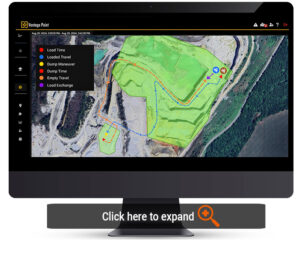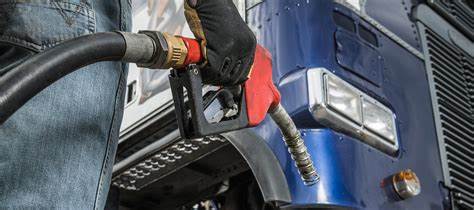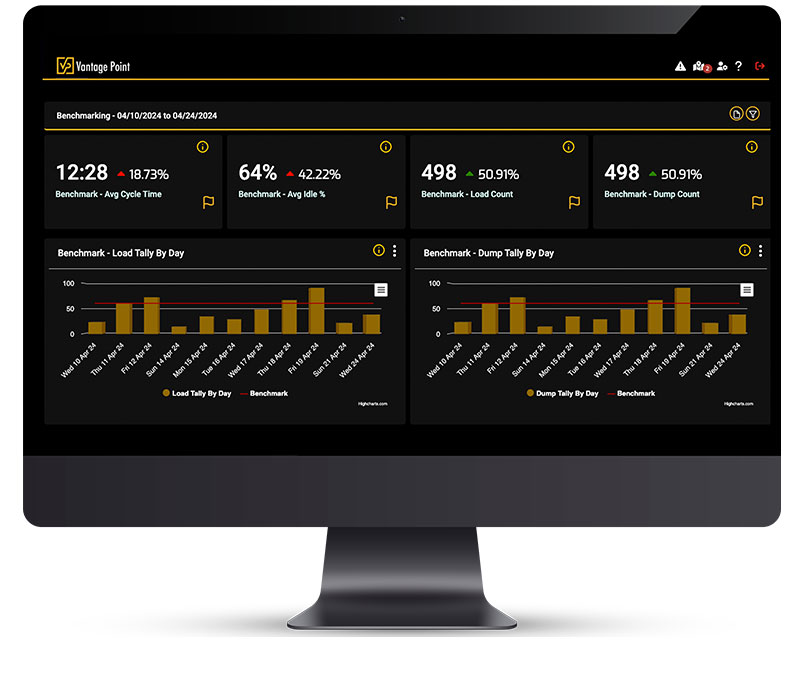Table of Contents
In the ever-evolving field of quarry management, real-time data has become a powerful tool, offering critical insights that enhance operations. From monitoring machine performance and material output to optimizing fuel consumption and improving safety protocols, real-time data gives quarry operators and managers the actionable intelligence needed to drive efficiency, reduce costs, and boost productivity.

This guide explores the flow of real-time data from sensors to centralized dashboards, illustrating how quarry operations can leverage these systems to streamline processes and foster continuous improvement.
Driving Operational Efficiency with Real-Time Insights
Boosting Equipment Utilization and Minimizing Downtime
One of the primary benefits of real-time data systems is their ability to monitor equipment performance continuously. Key metrics such as
- engine temperature
- hydraulic pressure
- and operational hours
can be tracked in real time, allowing operators to spot potential issues before they lead to costly breakdowns. Proactive maintenance becomes a reality, extending machinery lifespan and preventing unplanned downtime—crucial in an industry where operational continuity is key.
For example, by addressing operator habits that may cause inefficiencies, quarries can optimize equipment usage and identify areas for immediate improvement. In a real-world scenario, a quarry using a real-time data platform was able to pinpoint habits such as excessive idling and suboptimal machine usage. By correcting these behaviors, the site reduced equipment downtime and saved on operational costs.
Real-Time Fuel Management for Cost Savings
Fuel consumption is a significant expense in quarry operations. Real-time data enables managers to monitor fuel usage patterns closely, helping identify inefficiencies such as excessive idling or poor route planning for mobile equipment. Implementing adjustments based on these insights can lead to immediate fuel savings and contribute to broader cost-reduction strategies.

For example, tracking fuel
consumption alongside production output allows managers to optimize operations, ensuring resources are used efficiently. In one case, a quarry was able to reduce fuel costs by over 15% by analyzing machine usage patterns and fine-tuning processes accordingly. This kind of direct feedback loop, powered by real-time data, transforms how quarries approach fuel management, contributing not only to cost savings but also to sustainability goals by reducing carbon emissions.
Enhancing Safety through Predictive Analytics
Proactive Risk Management
Safety remains a top priority in quarry operations, and real-time data systems provide an additional layer of security by monitoring vital safety metrics continuously.
By using sensors to track machinery vibrations, worker proximity, and environmental factors like air quality, managers can identify potential hazards before they result in accidents.
Predictive analytics, powered by real-time data, allow for a forward-looking approach to safety. For instance, continuous monitoring of machinery vibrations might reveal patterns that suggest wear or damage. Acting on these early warnings can prevent mechanical failures that would otherwise pose a safety risk to workers. In fact, quarries that have adopted real-time safety monitoring have seen a measurable reduction in workplace injuries, with improvements in both worker safety and overall site morale.
Compliance and Record-Keeping
Beyond immediate safety improvements, real-time data also aids in regulatory compliance by maintaining accurate records of safety checks, equipment inspections, and incident responses. This not only ensures that quarries meet legal requirements but also fosters a proactive safety culture, where both management and workers are aligned in prioritizing on-site safety.
Centralized Dashboards for Smarter Decision-Making
Unified View of Operations
The key to unlocking the full potential of real-time data lies in its centralization. Aggregating data from multiple sensors and systems into a single dashboard provides quarry managers with a holistic view of operations. Dashboards can be customized to display key performance indicators (KPIs) that are most relevant to the site’s operational goals—whether it’s equipment performance, fuel efficiency, or safety compliance.
For instance, real-time alerts can be set up for maintenance needs, deviations from safety protocols, or equipment underperformance. This empowers managers to make swift, informed decisions that improve efficiency and prevent disruptions. With the ability to monitor multiple locations from a single interface, centralized dashboards streamline data management and eliminate the inefficiencies of manual reporting.
Fostering Team Collaboration
Centralized dashboards are not just for managers; they enable cross-team collaboration by providing a transparent, data-driven view of the operation. By allowing operators, foremen, and other stakeholders to access relevant data, quarry teams can collectively identify issues and develop solutions. This approach promotes accountability and encourages a culture of continuous improvement.
Real-World Success: Applying Data to Achieve Tangible Results
Quarry operators who have embraced real-time data are already reaping the rewards. In one case, a large family-owned quarry business struggled with equipment inefficiency and rising operational costs. By implementing a real-time data system, they were able to identify specific operator habits, such as excessive idling and inefficient machine use, that were driving up fuel costs and lowering productivity. With the ability to track long-term trends and make adjustments in real time, the company saw immediate and sustained cost savings, improving equipment utilization and reducing downtime across multiple sites.
Another quarry focused on safety enhancements. By tracking data from machine sensors, they were able to predict and prevent accidents before they occurred, leading to a 20% reduction in workplace injuries. These real-world examples demonstrate how data-driven insights can transform quarry operations, delivering measurable improvements in both efficiency and safety.
Implementing Real-Time Data Solutions
Getting Started
Implementing real-time data systems in a quarry doesn’t need to be complex. The first step is to identify the critical areas where data will have the most impact—be it equipment performance, fuel management, or safety monitoring. From there, installing the appropriate sensors and integrating them with a cloud-based platform will enable seamless data collection and analysis.
Investing in training is equally important. Employees must understand how to interpret the data and use it to inform day-to-day decisions. Additionally, establishing a system for regular maintenance and updates ensures that the technology remains effective over time.
Continuous Improvement through Data
Once real-time data systems are in place, the focus should shift to continuous improvement. By regularly reviewing data trends and adjusting strategies accordingly, quarry managers can ensure that their operations remain efficient, cost-effective, and safe. The ability to make informed, data-driven decisions is what sets leading quarries apart in today’s competitive landscape.
The integration of real-time data systems in quarry operations offers a powerful tool for boosting efficiency, improving safety, and reducing costs. With actionable insights derived from equipment performance metrics, fuel consumption patterns, and safety protocols, quarries can optimize their operations and drive continuous improvement. As real-world examples have shown, these systems are more than just a technological upgrade—they are a strategic investment in the future success of quarry operation


